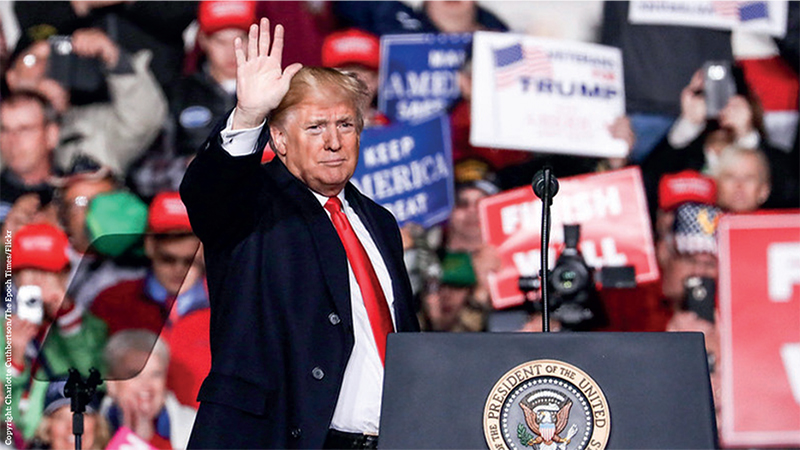Stockmarkets may be very excited at the prospect of a Trump victory, but bond markets are distinctly more circumspect. Even before the election result, the long end of the Treasury market had been rising, but Trump’s victory sent it higher. It is now 0.7% higher than its September lows in spite of interest rate cuts from the Federal Reserve.
The assumption is that Trump’s agenda will be inflationary. Trump has pledged to increase tariffs on imports. These could be as high as 60% for China and 20% for the rest of the world, though this is likely to be an opening negotiating position. He is also proposing tax cuts for businesses and individuals, which are also likely to raise prices. Tighter immigration policies are also likely to raise wages, as businesses lose a pool of cheap labour.
There are varying assessments of the likely impact. J.P. Morgan, for example, suggests this could push inflation up by 2.5 percentage points, while Goldman Sachs believes it could push core inflation above 3% in 2025. This could lead the Federal Reserve to raise rates and destabilise assumptions that rates are firmly on a downward path.
Jim Cielinski, global head of fixed income at Janus Henderson, said the market has already recalibrated its expectations: “The implied 10-year inflation projections embedded in Treasury markets rising to as high as 2.45% in the wake of the election, well above the September low of 2.03%. Similarly, futures markets have taken nearly 100 bps of cuts off the table by mid-2025 compared to what was expected only two months ago – a development that hints at inflation not yet being dead and buried.”
See also: Evelyn Partners’ Hollands: How to play US equities post election
The caveat is that Donald Trump will be acutely aware that inflation was part of the problem for the Democrats. Fairly, or unfairly, the Democrats were blamed for higher inflation and it hurt their electoral chances. He will be keen not to make the same mistake and may curb his actions to keep it lower.
Rising deficit
Part of the rise in US treasury yields over the past month is attributable to lower demand and higher issuance. Trump’s plans could raise the annual deficit by around $7.5bn, which could create some indigestion in treasury issuance.
Anthony Willis, investment manager on the multi-manager team at Columbia Threadneedle, said: “The US is already spending over 15% of federal revenue servicing debt costs, with the budget deficit close to 7% – a level usually only seen during a period of recession and high unemployment or a war.”
He is worried: “The US is more likely to see bond markets forgiving of even higher spending than other countries such as the UK or Europe – it helps when your currency is the global reserve – but under a Trump administration and his desire for further tax cuts combined with stimulus spending and a Congress unlikely to be minded to impose fiscal discipline suggests the US national debt will continue to climb higher. US debt is currently 99% of GDP and is projected to rise to 122% over the next decade.”
This will mean US government deficits are flooding markets with treasuries at the same time as quantitative tightening removes the Federal Reserve as a major buyer. There have already been concerns that the withdrawal of the Fed and a number of foreign governments from the market shifts the balance from yield-insensitive buyers to yield-sensitive buyers. Either way, it appears to be a recipe for higher yields.
Fed independence
Then there is a question over whether Trump will influence the independence of the Federal Reserve. Trump made his disdain for Fed chair Jerome Powell clear in his last term, frequently criticising his dovish stance. While he may not depose him, Trump may put a more malleable candidate at the helm when his term expires in less than a year.
Powell himself studiously avoided the question at the latest meeting. Willis said: “Powell avoided any discussion on the US election outcome, saying ‘we don’t know what the timing and substance of any policy changes will be’. Powell confirmed he would not resign if asked and noted that dismissal of any Fed board members was ‘not permitted under the law’. The Fed is likely to continue cutting for now but expectations for 2025 are shifting as investors consider what may be more inflationary policies from the new Trump administration.”
See also: Analysis: Is fixed income too expensive?
Cielinski said: “We believe protections are in place to ensure the Fed can pursue its statutory goals, unencumbered by the administration’s priorities. Still, Trump may leave his impression on the central bank by nominating and retaining members. We can expect jawboning around this topic to continue, but as was the case in his previous administration, such episodes would, in our view, largely be theatrics.”
However, it does create some vulnerabilities in the US treasury market, and the Jupiter Merlin multi-manager team has been reducing its macroeconomic exposure as a result.
John Chatfeild-Roberts, head of the team, said that they have been switching from strategic bonds to corporate bonds and high yield, “which are respectively removed further and further from the direct effect of interest rates and more towards the idiosyncrasies and financial risks of individual companies”.
He added: “Those types of bonds tend to be of shorter duration (ie on issue they typically have shorter maturity dates than government bonds); they come with different risks but the sensitivity to interest rates is much reduced.”
Willis agrees that a crisis may not be imminent, but ultimately even the US government will need to pay for its fiscal largesse and to keep its election promises. Even the all-powerful US may not be immune to a ‘Liz Truss’ moment of its own.








